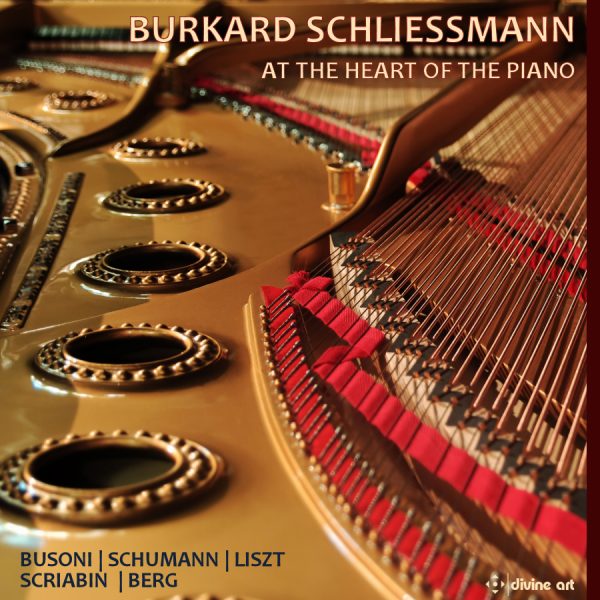Fanfare
At the Heart of the Piano, a three-disc release from Divine Art, presents German pianist Burkard Schliessmann in a recital of works by Bach (arr. Busoni), Schumann, Liszt, Scriabin, and Berg. The Bach/Busoni Chaconne and Berg Sonata receive their first release on this set. All the other recordings were previously issued by Bayer. The included Scriabin works were recorded in July, 1990, the Bach/Busoni Chaconne and Berg Sonata in 1994, the Schumann Fantasie and Liszt B-Minor Sonata in September 1999, and the Schumann Symphonic Études in March 2000. The new Divine Art set features 2021 remasterings by Paul Baily of all the included material. In the CD booklet’s extensive and informative liner notes, the uncredited author (Schliessmann, perhaps?) states: “Although at (a) glance the works offered here do not share any direct common ground, if considered more closely there are certain common factors with regard to their genesis over time and their conception….” Indeed, there are many elements that connect the works, and in an intriguing fashion. The composers appear in order of their birth years (if we use the “Bach” in “Bach/Busoni” as our start). Within that time progression, each of the three discs explores particular aspects of musical expression. Disc 1, comprising the Bach/Busoni Chaconne and the Schumann Symphonic Études, focuses on theme and variation structures. The second disc pairs the Schumann Fantasie in C Major with the Liszt B-Minor Sonata. Each of the composers dedicated his work to the other. Here Schumann and Liszt, in addition to writing music demanding a virtuoso of the highest order, explore the structural boundaries of the traditional piano sonata (and for that matter, sonata form). The final disc charts the trajectory of Scriabin’s increasingly daring harmonic world, a gateway to Berg’s atonality.
Just as the repertoire shares common elements, so do Burkard Schliessmann’s performances. Schliessmann plays all of this challenging repertoire with an impressively assured technique that is always at the service of the music. Schliessmann is a pianist who avoids such exaggerations as italicizing passages to showcase his virtuosity, extremes in tempo, or an excessive application of rubato. That said, Schliessmann’s interpretations exhibit a convincing ebb and flow, and the ability to draw upon a wide range of colors and dynamics to create the appropriate sound world for the work at hand. Schliessmann is also an artist with a keen sense of pacing. Both the Bach/Busoni and Schumann Symphonic Études are notable both for the accomplished and expressive way Schliessmann executes the variations, and the manner in which he connects one variation to the next. This sense of proportion serves Schliessmann and the music well in the Schumann Fantasie, and the Liszt, Scriabin, and Berg sonatas. The performances of the numerous brief Scriabin pieces also reflect the artist’s keen attention to pacing and architecture. A biography of the pianist, also part of the CD booklet, includes this appraisal from music critic Harold C. Schonberg: “Schliessmann’s playing is representative of the best of the modern school.” Based upon what I heard in this release, that seems a most apt characterization. The recordings are all excellent, a lifelike and marvelous reproduction of a concert grand. Perhaps these aren’t the most individual or viscerally thrilling performances of the works in question. But they are all beautifully played, unfailingly musical, and masterfully structured and paced. I found this recital immensely satisfying, and I am delighted to recommend it for your consideration.
@divineartrecordingsgroup
A First Inversion Company
Registered Office:
176-178 Pontefract Road, Cudworth, Barnsley S72 8BE
+44 1226 596703
Fort Worth, TX 76110
+1.682.233.4978










![Listen to the full suite of Marcel Dupré’s Variations Sur un Noël, Op. 20 from Alexander Ffinch’s #Expectations release today! listn.fm/expectations [in bio]](https://scontent-dfw5-1.cdninstagram.com/v/t51.71878-15/588904367_2327488161082898_8709236950834211856_n.jpg?stp=dst-jpg_e35_tt6&_nc_cat=105&ccb=7-5&_nc_sid=18de74&efg=eyJlZmdfdGFnIjoiQ0xJUFMuYmVzdF9pbWFnZV91cmxnZW4uQzMifQ%3D%3D&_nc_ohc=H8WFKm530VcQ7kNvwGfh5ZF&_nc_oc=AdkKrExvukPcWX7srO3AkxJdfygFmn1rsoKcZ0yw59UZi4JgF462GNrtm6he0RS_ngY&_nc_zt=23&_nc_ht=scontent-dfw5-1.cdninstagram.com&edm=ANo9K5cEAAAA&_nc_gid=UcuFGHLWBLCJf2p5cxPzvg&oh=00_AflMHgApXDqvwhM-bApdixbOpoB3V8lTl-diCUbz6pjXqA&oe=6954C06A)

![“the ‘Manteca’ Paraphrase – a rare foray into the two-piano medium but here played double-tracked – exudes a panache of which Dizzy Gillespie would surely have approved.… [a] recital well worth investigating.” —Gramophone Magazine with high praise for Ophelia Gordon's debut release, Kapustin: Between the Lines!](https://scontent-dfw5-3.cdninstagram.com/v/t51.82787-15/598796470_18303255136283342_540941604740887837_n.jpg?stp=dst-jpg_e35_tt6&_nc_cat=108&ccb=7-5&_nc_sid=18de74&efg=eyJlZmdfdGFnIjoiRkVFRC5iZXN0X2ltYWdlX3VybGdlbi5DMyJ9&_nc_ohc=IC4zZ7tcpb8Q7kNvwERLVTM&_nc_oc=Adl5x3Esme0kvrFSlKOezY2GH8NSqpj0B3EGhb0nFsz8ZT-p5hmmLIRK6u419CfQG6U&_nc_zt=23&_nc_ht=scontent-dfw5-3.cdninstagram.com&edm=ANo9K5cEAAAA&_nc_gid=UcuFGHLWBLCJf2p5cxPzvg&oh=00_AfkyjzH5jPPP3r3JIdsbxpMwPsq5iz6leTiBdCWk_XeQ0g&oe=6954D304)